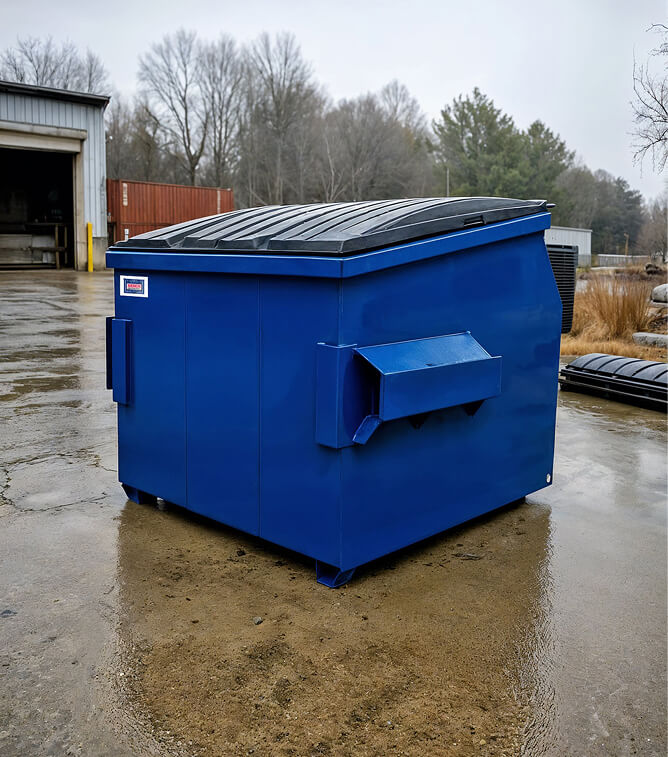Front-loading containers are essential workhorses in commercial waste management, handling thousands of pounds of waste daily. Behind their simple appearance lies sophisticated engineering that ensures these containers can withstand extreme forces and years of heavy use. Understanding the structural engineering principles is crucial for manufacturers, fleet managers, and facility operators who depend on reliable waste collection.
The Engineering Challenge
Front-loading containers face unique structural demands that set them apart from other waste collection systems. Unlike rear-loading containers, front-loaders must support their entire weight and contents from a single lifting point at the front. This creates concentrated stress points requiring careful engineering solutions.
The primary challenges include dynamic loading when hydraulic arms lift full containers with forces exceeding 15,000 pounds, cyclic stress from thousands of annual lift cycles that can cause metal fatigue, and environmental exposure to all weather conditions, plus corrosive materials that weaken structural components over time.
Core Structural Components
Frame Architecture
The backbone of any front-loading container is its structural frame, typically constructed from high-strength steel. Modern designs employ tubular frame systems that offer superior strength-to-weight ratios compared to traditional solid beam construction.
The frame geometry follows engineering principles that distribute loads through multiple paths. When lifted, forces travel from the lifting eyes through upper frame rails, down vertical supports, and into the base structure. This multi-path design ensures that if one component experiences stress concentration, adjacent members share the load.
Lifting Eye Design
Lifting eyes represent the most critical structural element, interfacing directly with collection truck hydraulic arms. These components feature reinforced steel construction with generous fillet welds that gradually transfer loads into the main frame structure.
Advanced designs incorporate stress concentration analysis to optimize eye geometry. Rather than simple circular holes, modern lifting eyes often feature elliptical shapes that better distribute forces and reduce peak stress levels. Attachment points use full-penetration welds backed by reinforcement plates spreading loads across wider frame areas.
Base Structure Engineering
The container base must support content weight while remaining rigid enough to prevent sagging that could interfere with lifting operations. Contemporary designs employ cross-member systems with steel tubes creating grids that distribute weight evenly, plus reinforced floor plating using heavy-gauge steel with strategic reinforcement ribs that add strength and create drainage channels.
Material Science Applications
Steel Selection and Properties
Steel grade choice significantly impacts container performance and longevity. Most manufacturers use high-strength, low-alloy (HSLA) steels providing excellent strength characteristics while maintaining good weldability and corrosion resistance.
Common specifications include ASTM A572 Grade 50, offering 50,000 PSI minimum yield strength with good ductility, ASTM A606 Type 4 providing enhanced atmospheric corrosion resistance, and ASTM A847 specifically designed for cold-formed structural applications.
Steel thickness varies by location within the container structure. High-stress areas like lifting points and frame joints typically use heavier gauge material, while less critical areas employ thinner sections to optimize weight and cost.
Welding Technology
Modern container manufacturing employs advanced welding techniques, ensuring structural integrity throughout service life. Gas metal arc welding (GMAW) with appropriate filler materials creates strong, consistent joints often exceeding base material strength. Critical welds undergo non-destructive testing, including visual inspection and dye penetrant testing to verify quality and detect potential defects.
Load Distribution Analysis
Finite Element Modeling
Contemporary container design relies heavily on finite element analysis (FEA) to optimize structural performance. These computer simulations model entire container structures and apply realistic load conditions to identify stress concentrations, deflection patterns, and potential failure modes.
FEA allows engineers to test multiple design iterations virtually, optimizing material placement and geometry before building physical prototypes. This significantly reduces development time and costs while improving final product performance.
Real-World Load Testing
Despite advanced modeling capabilities, physical testing remains essential for validating design performance. Manufacturers conduct static load tests applying forces 150-200% of rated capacity to verify structural adequacy. Dynamic testing simulates actual service conditions by repeatedly cycling containers through lifting operations while monitoring stress levels and checking for fatigue or deformation signs.
Fatigue Resistance Engineering
Metal fatigue represents the primary long-term threat to container structural integrity. Repeated loading creates microscopic cracks that gradually propagate until reaching critical size and causing failure.
Engineers address fatigue through stress concentration reduction using generous radius transitions and avoiding abrupt geometry changes, material selection specifying steels with good fatigue resistance properties, and proper joint design including appropriate weld profiles and post-weld treatments that significantly improve fatigue performance.
Innovation and Future Directions
Smart Structure Integration
The latest generation containers incorporates smart technology monitoring structural health in real-time. Strain gauges and accelerometers embedded within structures provide data on load levels, lift cycles, and potential overload conditions. This enables predictive maintenance programs identifying developing problems before failure occurs.
Lightweight Design Advances
Environmental regulations and fuel efficiency concerns drive demand for lighter containers maintaining full structural capability. Advanced engineering techniques enable weight reduction through topology optimization using computer algorithms to identify efficient material distribution, high-strength materials offering improved strength-to-weight ratios, and hybrid construction combining different materials optimally.
Quality Assurance
Structural integrity begins with consistent manufacturing processes employing statistical process control monitoring key parameters like weld penetration, material thickness, dimensional accuracy, and joint alignment. Automated inspection systems using machine vision ensure consistent quality while reducing costs.
Conclusion
Advanced structural engineering transforms simple waste containers into sophisticated systems capable of reliable operation under demanding conditions. Through careful attention to load distribution, material selection, fatigue resistance, and manufacturing quality, engineers create containers providing years of dependable service while minimizing maintenance requirements.
Understanding these engineering principles helps stakeholders make informed decisions about container selection, maintenance, and replacement. As technology advances, we can expect more sophisticated solutions integrating advanced materials, smart monitoring systems, and data-driven optimization creating the next generation of waste collection equipment built upon solid structural engineering foundations.






Comments